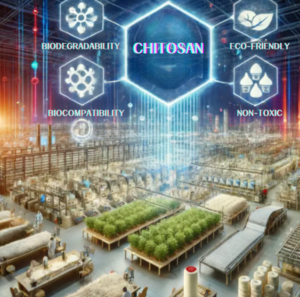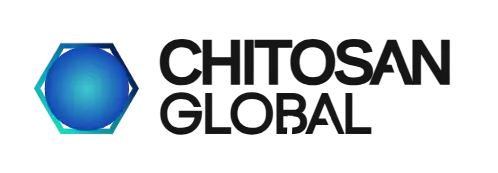


1. What is Mushroom Chitosan?
Mushroom chitosan is a natural biopolymer extracted from the cell walls of fungi. It’s derived from chitin, a structural component that gives mushrooms their rigidity and form.
Origin and Abundance
- Chitin is the second most abundant natural polysaccharide in nature, after cellulose.
- Most fungi contain 5%-7% chitin in their cell walls.
- Chitin is also found in the exoskeletons of crustaceans (crabs, shrimp, lobsters) and insects.
Comprehensive Pronunciation Guide for Understanding Mushroom Chitosan
- Chitin: Pronounced “KITE-in” (emphasis on “kite”)
- Deacetylation: Pronounced “dee-a-SETTLE-ay-shun” (emphasis on “dee”)
- Acetyl: Pronounced “A-see-tl” (emphasis on “see”)
Chemical Structure and Properties
Chitosan is obtained through a process called deacetylation of chitin. This involves:
- Removing acetyl groups (CH3OH) from the chitin molecule
- Creating a polymer with free amine groups (NH2)
This chemical transformation gives chitosan its positive charge, differentiating it from its parent compound, chitin.
- Solubility: Unlike chitin, chitosan is soluble in acidic to neutral solutions, making it more versatile for various applications. Our food grade mushroom chitosan oligosaccharide is soluble in water at any pH. It is bactericidal at pH 6.4 and below. To purchase wholesale, click HERE
- Biocompatibility and Biodegradability: Chitosan is known for its excellent biocompatibility and biodegradability. It’s non-toxic and can be broken down by natural biological processes.
Uses and Applications:
Chitosan, a versatile biopolymer derived from chitin, has found widespread applications across multiple industries due to its unique properties. This biodegradable and non-toxic compound offers a range of benefits in various sectors:
- Healthcare and Pharmaceuticals: Chitosan’s biocompatibility makes it invaluable in medical applications. It is used in wound healing products, drug delivery systems, and as a biomaterial in tissue engineering. Its ability to promote healing and control drug release has made it a popular choice in the pharmaceutical industry.
- Environmental Protection: In water treatment, chitosan’s capacity to bind with heavy metals and other contaminants makes it an effective agent for purification processes. This property has led to its use in both industrial and municipal water treatment facilities.
- Agriculture: Farmers and agronomists utilize chitosan as a natural biostimulant and elicitor. It enhances plant growth and boosts resistance against pathogens, contributing to more sustainable agricultural practices.
- Food Industry: Chitosan serves multiple purposes in food production and preservation. It acts as an antimicrobial food additive and can be used to create edible films or coatings that extend the shelf life of perishable products.
- Beverage Production: In the alcoholic beverage industry, chitosan is employed for clarification of wines, beers, and whiskeys, helping to improve their clarity and stability.
- Dietary Supplements: The compound is also used in the production of dietary supplements, capitalizing on its potential health benefits.
- Plastics Industry: Chitosan’s biodegradable nature makes it an attractive option for developing eco-friendly plastic alternatives.

The wide-ranging applications of chitosan stem from its unique combination of biocompatibility, biodegradability, and non-toxicity. As research continues, it’s likely that even more uses for this versatile compound will be discovered across various industries.
Variants:
- Traditional Chitosan: Traditionally sourced from marine crustaceans.
- Mushroom Chitosan: Derived from fungal sources, offering an alternative for those seeking non-animal derived products.
Chitosan’s versatility, biodegradability, and non-toxic nature make it a valuable material across various industries, from healthcare to cosmetics. Its ability to be derived from non-animal sources also makes it an appealing option for vegetarian and vegan-friendly products.
2. What are the advantages of Mushroom Chitosan?
Mushroom Chitosan is a type of chitosan derived from the cell walls of fungi. It has several advantages over traditional chitosan derived from shellfish, including:
- 1. Vegan and vegetarian-friendly: Mushroom chitosan is an excellent alternative for individuals who avoid animal-based products, such as those who follow a vegan lifestyle.
- 2. Allergen-free: Traditional chitosan is derived from shellfish, which can cause allergic reactions in some people. Mushroom chitosan does not contain any shellfish-derived ingredients, making it an allergen-free option.
- 3. Purer: Mushroom chitosan is often considered to be purer than traditional chitosan because it is derived from a single source, whereas traditional chitosan can be contaminated with other shellfish-related substances.
- 4. Better solubility: Mushroom chitosan is more soluble than traditional chitosan, which makes it easier to incorporate into a variety of applications such as cosmetics, bioplastics, wound care and food.
- 5. Improved bioavailability: Some studies have suggested that mushroom chitosan has higher bioavailability compared to traditional chitosan, which means that it can be absorbed and utilized more effectively by the body.

Overall, mushroom chitosan offers several advantages over traditional chitosan, making it an attractive alternative for individuals and industries looking for a vegan, allergen-free, and more effective chitosan source.
3. What are the benefits & functions of chitosan in textile uses?
Chitosan, derived from sources such as mushrooms & aspergillus niger, offers several benefits and functions when applied in textiles:
Benefits of Mushroom Chitosan in Textiles:
- Biodegradability: Chitosan, being a natural biopolymer, offers an ecologically sound alternative to synthetic agents. Its biodegradable, biocompatible and non-toxic nature contributes to reducing environmental impact, aligning with sustainable textile manufacturing practices.



- Non-Toxicity: Unlike many chemical additives, chitosan is non-toxic, making it safe for use in a wide range of textile applications, including those that come into close contact with skin.

- Biocompatibility: Its inherent biocompatibility makes it particularly valuable in medical textiles, where it poses minimal risk of skin irritation or allergic reactions, a crucial factor in healthcare-related fabric applications.

Functions of Chitosan in Textiles:
- Antimicrobial Properties: Chitosan’s antimicrobial properties are pivotal in inhibiting microbial growth, making it ideal for hygiene-critical applications such as medical textiles, sportswear, and inner-wear. This function is vital for maintaining sanitary conditions and preventing odor buildup in fabrics.

- Moisture Absorption and Breathability: Its ability to absorb moisture enhances fabric breathability and comfort, especially in apparel textiles where moisture control is essential for wearer comfort.

- Strength and Durability: The incorporation of chitosan can bolster the mechanical strength and durability of textiles, thus extending the lifespan and wearability of the fabric.

- UV Protection: Chitosan-treated textiles offer a shield against harmful ultraviolet rays, adding a layer of protection that is especially beneficial in outdoor and sun-exposed garments.

- Wound Healing (in Medical Textiles): Leveraging its wound healing capabilities, chitosan is invaluable in medical textiles, promoting healing processes in wound dressings and other medical fabrics.

- Odor Resistance: Reduces odors in textiles, making them more pleasant to wear.

- Water Treatment: Beyond traditional textiles, chitosan-coated fabrics can be utilized in innovative water treatment applications, exploiting its ability to bind with heavy metals and pollutants, offering a novel approach to water purification.

- Flame Retardancy: Incorporating chitosan imparts flame-retardant properties to textiles, an essential function for safety in various applications, including upholstery, draperies, and protective clothing.
- Static Resistance: In synthetic fabrics, chitosan can help reduce static build-up, enhancing comfort and usability in diverse textile products.

Mushroom chitosan plays a multifaceted role in the textile industry. Its benefits extend from enhancing environmental sustainability and safety to improving the functional properties of fabrics. Its versatility and eco-friendly profile make it an increasingly popular choice in the ongoing evolution of textile technology and sustainable practices.
4. What are the common forms of mushroom chitosan used in textile uses?
In the textile industry, chitosan is utilized in several common forms, each catering to specific functionalities and applications, with provided specific dosage suggestions for each form of chitosan in textile applications:
- Fiber Form:
- Chitosan fibers are directly woven or blended with other natural or synthetic fibers to create composite fabrics. This integration imparts chitosan’s unique properties, such as antimicrobial and moisture-wicking abilities, directly into the fabric structure.
- When chitosan is integrated into fibers, the concentration can vary significantly. A common ratio might be anywhere from 5% to 30% of chitosan blended with other fibers. The exact ratio depends on the desired properties and the compatibility with other fibers.
- Fiber Form:

- Powder Form:
- As a fine powder, chitosan can be applied to textiles through various finishing processes. The powder form is particularly useful for treatments that require a more surface-level application, enabling easy integration with other textile finishing chemicals.
- For powder application, the dosage can vary from 1% to 5% by weight of the fabric, depending on the desired effect. Higher concentrations generally provide more pronounced antimicrobial and durability effects.
- Powder Form:

- Solution or Liquid Form:
- Chitosan is often dissolved in a liquid medium (usually in acetic acid or other solvents) to create a solution. This chitosan solution can be applied to textiles through techniques like padding, spraying, or coating. This method is especially effective for treatments aiming to provide a thin, even coating over the fabric, useful for antimicrobial finishes or UV protection.
- In solution form, chitosan is often used in concentrations ranging from 0.5% to 2% (w/v). The exact concentration depends on the method of application (e.g., padding, spraying) and the desired finish.
- Solution or Liquid Form:

- Gel Form:
- In some applications, chitosan is used in a gel-like form, which is suitable for coating or impregnating textiles. This form is particularly beneficial for medical textiles, where a more substantial layer of chitosan can aid in wound healing and antibacterial properties.
- Gel applications, particularly in medical textiles, can vary widely in concentration. Typically, a gel containing 1% to 3% chitosan might be used, but this can be adjusted based on the required thickness and therapeutic effect.
- Gel Form:

- Nano-form or Micro-encapsulation:
- Chitosan nanoparticles or microcapsules are used for more targeted and controlled release of the chitosan’s properties. These nano-scale or micro-encapsulated forms can be integrated into fabrics to provide specific functionalities like gradual release of antimicrobial agents or targeted application in smart textiles.
- The dosage of nano-sized or micro-encapsulated chitosan is typically quite low, as the encapsulation increases the efficiency of the active substance. Concentrations as low as 0.1% to 1% can be effective.
- Nano-form or Micro-encapsulation:

- Composite Form:
- Chitosan is also used in composite materials, where it is combined with other polymers or additives to enhance or modify its properties. These composites can be tailored for specific functional requirements like increased durability, enhanced moisture management, or improved biodegradability.
- In composite materials, chitosan is usually combined with other polymers or additives at ratios that depend heavily on the desired end properties. For instance, a 5% to 20% chitosan composite might be used to enhance antimicrobial properties or fabric strength.
- Composite Form:

- Film Form:
- Chitosan films, created by drying chitosan solutions, can be applied to textiles. These films are particularly useful in packaging and protective clothing, where they provide a barrier against microorganisms and external elements.
- Chitosan films are generally created from solutions with a higher concentration, possibly around 2% to 4%, to ensure the film’s integrity and effectiveness. The exact concentration depends on the desired film thickness and application.
- Film Form:

Each form of chitosan offers different advantages and is chosen based on the desired outcome, the nature of the textile material, and the specific requirements of the end product. The versatility of these forms allows for widespread use in various textile applications, from everyday wear to high-tech and medical textiles.
It’s important to note that these are approximate guidelines. The optimal dosage and concentration of chitosan in each form should be determined through experimentation and testing, considering the specific requirements of the textile product and its intended use. Additionally, the processing conditions, such as temperature and time, play a significant role in the effectiveness of chitosan in each form.
5. Considering solubility and viscosity, which type of chitosan is optimal for textile applications?
The choice of the best type of chitosan for textiles depends on the specific application and desired properties of the finished product. Each type of chitosan mentioned has unique characteristics that make it suitable for different textile applications:
- Acid-Soluble Chitosan:
- Best for applications where a soluble form is needed, like coatings or treatments in liquid form.
- Useful for creating films or sheaths on fibers.
- Acid-Soluble Chitosan:
- Chitosan Hydrochloride (Water-soluble):
- Soluble in water, making it convenient for applications where water solubility is a priority.
- Often used in dyeing processes and for antimicrobial finishes.
- Chitosan Hydrochloride (Water-soluble):
- Chitosan Oligosaccharide (Water-soluble):
- Has a lower molecular weight, leading to better solubility and penetration into fibers.
- Ideal for applications requiring deeper penetration into the fabric, like deep conditioning or functional treatments.
- Chitosan Oligosaccharide (Water-soluble):
- Carboxymethyl Chitosan (Water-soluble):
- Highly water-soluble and has enhanced biocompatibility.
- Often used in medical textiles and skin-friendly applications.
- Carboxymethyl Chitosan (Water-soluble):
Regarding viscosity, it largely depends on the method of application and the desired effect:
- Lower Viscosity (20-200 cps):
- Better for processes like spraying or dipping, where a thinner, more penetrative solution is needed.
- Suitable for light coatings and treatments that require minimal alteration of the fabric’s hand feel and drape.
- Lower Viscosity (20-200 cps):
- Higher Viscosity (200-1000 cps):
- Better for heavier coatings, where a thicker layer is required.
- Ideal for applications where a substantial layer of chitosan is beneficial, such as in certain types of medical textiles or protective coatings.
- Higher Viscosity (200-1000 cps):
The choice of chitosan type and viscosity should align with the specific requirements of the textile application, including factors like the fabric type, desired properties (e.g., antimicrobial, UV protection, moisture management), and the application process. Often, trial and testing are necessary to determine the most suitable type and viscosity of chitosan for a given textile product.
6. What distinguishes crustacean chitosan from mushroom chitosan in textile applications?
Crustacean chitosan and mushroom chitosan, while similar in their basic chemical structure, have some key differences, particularly in their source, properties, and implications for use in textiles:

1). Source
- Crustacean Chitosan: Derived primarily from the shells of crustaceans like shrimp, crabs, and lobsters. These shells are a byproduct of the seafood industry and are the most common source of chitosan.
- Mushroom Chitosan: Sourced from fungi, such as mushrooms or Aspergillus Niger. This form of chitosan is an alternative for those seeking non-animal-based sources.
2). Allergenic Potential
- Crustacean Chitosan: May pose allergenic risks for individuals allergic to shellfish. Its use in textiles that come into direct contact with skin could be a concern for this demographic.
- Mushroom Chitosan: Generally considered hypoallergenic and is a safer choice for people with shellfish allergies. This attribute makes it particularly suitable for textiles used in clothing and medical applications.
3). Environmental and Ethical Considerations
- Crustacean Chitosan: While it uses a byproduct of the seafood industry, there are environmental and ethical considerations regarding the sourcing from sea creatures.
- Mushroom Chitosan: Often viewed as more sustainable and ethical, particularly appealing to vegan and environmentally conscious consumers and manufacturers.
4). Molecular Structure and Properties
- Crustacean Chitosan: Typically has a higher degree of deacetylation, which can influence its solubility and effectiveness in certain applications.
- Mushroom Chitosan: The molecular structure may differ slightly due to its fungal origin. These differences can affect its solubility, biocompatibility, and interaction with textile fibers.
5). Application in Textiles
- Crustacean Chitosan: Commonly used for its antimicrobial properties, strength enhancement, and moisture management in textiles.
- Mushroom Chitosan: Also valued for similar properties but is especially preferred in applications where hypoallergenic or vegan materials are important.
6). Regulatory and Market Aspects
- Crustacean Chitosan: More widely used and researched, with established supply chains.
- Mushroom Chitosan: Emerging as a popular alternative, with increasing research and market presence, especially in sectors prioritizing sustainable and ethical materials.
In summary, while both types of chitosan offer beneficial properties for textile applications, the choice between crustacean and vegetal chitosan often comes down to considerations of allergies, sustainability, ethical sourcing, and specific molecular properties required for the textile application.
7. Which source of chitosan (crustacean or vegetal) is more suitable for each form used in textiles?
The choice of source for chitosan – whether crustacean or vegetal – for different forms used in textiles depends on various factors, including the desired properties, application methods, and sustainability considerations. Here’s a general guideline for which source might be better for each form:
1). Fiber Form
- Crustacean Chitosan: Offers strong antimicrobial properties and durability, useful for durable and hygienic textiles.
- Mushroom Chitosan: Preferred for hypoallergenic applications and for consumers seeking vegan materials.
2). Powder Form
- Crustacean Chitosan: Effective for general antimicrobial and strength-enhancing applications.
- Mushroom Chitosan: Better suited for environmentally conscious brands and for textiles marketed as vegan or organic.
3). Solution or Liquid Form
- Crustacean Chitosan: Commonly used for its strong antimicrobial properties in coatings.
- Mushroom Chitosan: Ideal for applications where a non-animal-derived product is crucial, such as in eco-friendly or hypoallergenic textiles.
4). Gel Form
- Crustacean Chitosan: Effective for wound-healing medical textiles due to its strong bioactive properties.
- Mushroom Chitosan: Preferred in medical textiles where hypoallergenic properties are important, or for vegan products.
5). Nano-form or Micro-encapsulation
- Crustacean Chitosan: Offers effective controlled release properties due to its molecular structure.
- Mushroom Chitosan: Suitable for applications requiring environmentally friendly and non-animal-derived materials.
6). Composite Form
- Crustacean Chitosan: Good for enhancing strength and antimicrobial properties in composites.
- Mushroom Chitosan: Used in composites for eco-friendly or vegan textiles, or when hypoallergenic properties are required.
7). Film Form
- Crustacean Chitosan: Creates effective films for protective textiles due to its strong barrier properties.
- Mushroom Chitosan: Ideal for sustainable, eco-friendly packaging solutions or textiles.
Conclusion
In choosing between crustacean and mushroom chitosan, consider factors like the target market, environmental and ethical concerns, the specific properties required in the textile application, and potential allergy considerations. Both sources offer unique benefits, and the best choice varies depending on the specific requirements and values of the end product.
8. Summarizing mushroom chitosan applications in textiles
In the evolving landscape of textile innovation, mushroom chitosan emerges as a frontrunner, offering a harmonious blend of environmental sustainability and functional superiority. Sourced ethically from non-animal origins like mushrooms and Aspergillus Niger, this biopolymer is capturing the attention of the industry, particularly for clients seeking eco-friendly and hypoallergenic alternatives.
Mushroom chitosan stands out for its remarkable versatility, being adaptable in various forms such as fiber, powder, and liquid solution, each a fit with specific textile applications. Its integration into fabrics enhances properties like antimicrobial effectiveness, moisture management, and UV protection, all while maintaining a gentle footprint on the environment.

As the textiles move steadily toward sustainably sourced materials, mushroom chitosan makes future innovations limitless. Whether it’s in medical textiles requiring hypoallergenic properties, performance wear demanding moisture-wicking capabilities, or eco-conscious fashion seeking sustainable materials, mushroom chitosan offers a solution that is highly adaptable. Its potential extends beyond traditional textiles, finding novel applications in water treatment and smart fabric technologies.
For companies in the textile industry, adopting mushroom chitosan not only means investment in quality and functionality but also contributing to a greener, more sustainable futurem.
Book a Free Consultation
If you don’t know what type of chitosan is best for your situation, Book an appointment. we will offer you an initial 30-minute consultation and product quotation at no charge.
